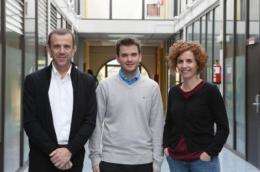Improving 3-D image capture in real time

A team of researchers of the Public University of Navarre has developed a technique that enables the processing in real time of 3-D images to be improved. The work, which has applications for 3-D video, aeronautics, the automotive sector or intelligent systems for operating theatres, for example, has been published in the American journal IEEE Transactions on Pattern Analysis and Machine Intelligence, a leading publication in terms of its impact in the field of Computational Sciences and Artificial Intelligence.
This research comes within the framework of the PhD thesis that Leonardo de Maeztu-Reinares, a Telecommunications Engineer, has developed at the Public University of Navarre. Co-authors of the paper are Rafael Cabeza-Laguna and Arantxa Villanueva-Larre, lecturers in the Department of Electrical Engineering and Electronics.
The work is based on stereoscopic vision, a technique for obtaining 3-D images. "The basic principle of stereoscopy is the use of two or more cameras that simultaneously pick up the same scene from different positions, similar to what human eyes do," say the authors. That way, two or more images are captured for each instant in time and are compared with each other to work out how far the objects are from the cameras, and that way capture the depth lacking in a classical photograph, which is two-dimensional."
According to the authors, this comparison of two stereoscopic images requires "a considerable computational load and great algorithmic complexity," if accurate results are to be produced. In actual fact, the work published proposes that three modifications be made to the algorithms (understood as operations or instructions) that allow a technique to be reused; this used to be known as the so-called anisotropic diffusion in order to compare pairs of stereoscopic images.
"The algorithm proposed," says Leornardo de Maeztu, "yields better results than other previous ones in the same class and, what is more, presents a very interesting competitive advantage: it can be implemented in real time using a standard graphics card. Although they are algorithms that require a great calculating capacity, if the whole potential of current graphics processors is used, it is possible to execute in real time, in other words, to process as many images per second as those caught by the corresponding camera."
Applications of stereoscopic vision
This research into stereoscopic vision has applications in fields like 3-D video recording, the monitoring of the environment in vehicles (unmanned planes and helicopters, vehicles, etc.) or intelligent systems for operating theatres.
According to the classification of Journal Citation Reports (JCR) which appraises world scientific journals, the publication "IEEE Transactions on Pattern Analysis and Machine Intelligence", which includes the article by the researchers at the Public University of Navarre, leads the world ranking within the ones devoted to Computational Sciences and Artificial Intelligence in terms of its impact factor. It is published by the IEEE (Institute of Electrical and Electronics Engineers), a worldwide professional organisation with its headquarters in the United States and which brings together nearly 400,000 professionals in the new technologies.
Provided by Elhuyar Fundazioa





















